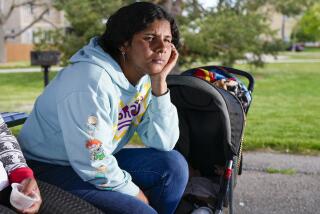Cervical Cancer Cuts Swath Along Border
- Share via
WESLACO, Texas — Neighbors of Maria Guadalupe Hernandez call her “la flaquita,” the thin one.
She was sick when she sneaked across the border from Mexico five years ago, penniless from paying doctors who misdiagnosed her cervical cancer.
“I had to sell my house to pay medical bills in Mexico,” she said in Spanish during an interview in her hospital room. “The children were hungry.”
She is still battling the disease.
Hernandez represents a statistic that continues to baffle and shame health officials. At 35, the mother of eight and grandmother of two likely will die from a cancer that health officials say should have been eradicated decades ago.
For women around the world, the Pap smear has detected cell abnormalities that can be treated long before they develop into cancer.
But mortality rates have held frustratingly steady in some regions plagued by poverty, language barriers and young motherhood. The rates indicate that women are not getting the Pap test or are not pursuing follow-up care when the tests show abnormalities.
The 19-county U.S.-Mexico border area known as the Rio Grande Valley is one of those regions. Other trouble spots include five counties in Maine; 14 counties in rural Alabama; a chunk of West Virginia; parts of California; and concentrations of Native Americans in the Southwest and Alaska.
Worldwide, almost 360,000 cases of cervical cancer were detected in 1990, with 190,000 women dying of the disease. Women in Third World countries have relatively high incidence of sexually transmitted diseases, including the human papilloma virus that is a precursor to cervical cancer.
The Rio Grande is hardly a boundary when it comes to health issues. Young doctors training in crowded hospitals here may encounter diseases seen nowhere else in the country, including dengue fever and canine rabies.
Recognizing this, the federal health department is funding basic health needs including reproductive care, vaccinations for children and treatment for communicable diseases such as tuberculosis.
There also is a lack of education about preventive care. Women with no health insurance who are isolated by language and culture may go years without seeing a doctor.
“I saw one woman who was over 50 years old and having her first Pap,” said Sister Mary Nicholas, a registered nurse with the Texas Department of Health’s regional office.
By the time the cancer is caught, it’s often far advanced. The incidence rate for cervical cancer in the Rio Grande between 1995 and 1997 was 13.6 per 100,000 women. From 1994 to 1998, that figure was 8.5 per 100,000 women nationwide.
Just as much a factor is a failure at continuing care. Even when a Pap smear comes back abnormal, a woman may forego the follow-up. The results are a regional mortality rate at 3.8 per 100,000, compared to 2.3 per 100,000 nationwide.
“They may be afraid; they don’t want to know they’re sick. But the message we have to convey is: ‘Get that Pap,’ ” said Jane Delgado, president and CEO of the National Alliance for Hispanic Health and author of “Salud,” a health guide for Hispanic women.
The National Cancer Institute is generating a report on the disproportionate rates of cervical cancer around the United States and what can be done about them.
“Fifty years after the introduction of the Pap smear, which should eliminate cervical cancer, we still had these high rates in these counties,” said NCI’s Dr. Jon Kerner, who is working with several agencies to eradicate the disease.
Under the Breast and Cervical Cancer Prevention and Treatment Act passed by Congress last year, states are eligible for federal Medicaid matching funds to provide free medical care to low-income women diagnosed with breast or cervical cancer.
Texas plans to take advantage of the initiative. A state law that went into effect Sept. 1 provides free breast and cervical cancer treatment to women who have no insurance but whose incomes are too high for Medicaid.
The effort may come too late for Hernandez.
Tucked here and there along the border are “colonias”--settlements of mostly poor Mexican nationals that take root wherever a landowner allows trailers, old school buses or flimsy shacks.
In recent years, community outreach workers known as “promotoras” have tried to get colonia residents in touch with health care and other services.
One such “promotora” found Hernandez in a cinder-block shack last May, lying nearly unconscious on the floor in a pool of blood.
“It was probably the most advanced cervical cancer any of us had seen,” said Dr. Hhabib Ghaddar, an oncologist. “Frankly, any cervical cancer is advanced because we shouldn’t be seeing invasive cervical cancer at all.”
Media reports about Hernandez prompted an outpouring of donated clothes and toys for the children--the youngest is 3, the eldest 17. The county helped move the family into a rental house. Health officials saw to it that the children were immunized so they could attend school.
But within months, the money was running out and Hernandez moved the children into a trailer. The cost: roughly $250 a month.
Today, the disease has left Hernandez weakened, often unable to eat. The children have been sent home from school with lice. They share one mattress on the floor. The only shower is an outside garden hose.
An account opened by Texas State Bank in Hernandez’s name recently had a balance of $6.
More to Read
Sign up for Essential California
The most important California stories and recommendations in your inbox every morning.
You may occasionally receive promotional content from the Los Angeles Times.












